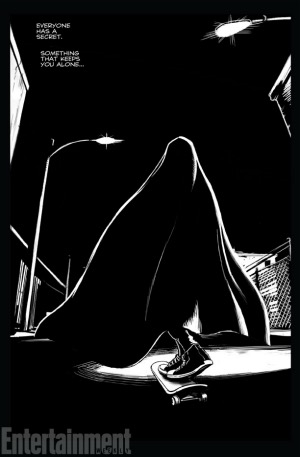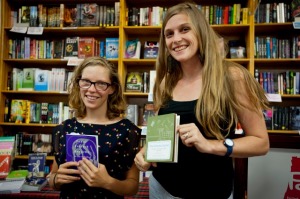Rampant Media Consumption – February/March 2015
 RMC is going monthly (turns out we’re all too busy producing media to consume enough of it to report on a weekly basis). So: here’s what we took in during the last month+.
RMC is going monthly (turns out we’re all too busy producing media to consume enough of it to report on a weekly basis). So: here’s what we took in during the last month+.
Taylor
watched: a girl walks home alone at night
read: susan howe poems via google search of her name, and a little bit of pale fire by nabokov
heard: rhianna’s new song on every radio station. not a fan 🙁
Meggyn
heard: Curtis Harding’s (Burger Records), D’Angelo covers (I especially love his rendition of this), Marvin Gaye’s Here, My Dear, Curtis Mayfield, Caribou (I saw him on Tuesday this week at the Roseland), WAND, and some Brothertiger.
read: a few pages of Middlesex. I was distracted by the dirty glass I got of scotch at a dive…so I stopped. However, one of my dearest friends gave me a handful of books before leaving to Brooklyn last week, and I plan to dive into those.
looked at: checked out the artists from the Bellingham Comic Arts Festival…I’m really looking forward to meeting them (Emily McGratten, Liz Yerby, and Ben Duncan to name a few)
watched: A Girl Walks Home Alone At Night. One of the greatest films I have seen in a long time. I went home obsessing over it and wanting to watch it over and over.
Elly
This month I was traveling most of the time and sick part of the time. In that time I managed to read four novels:
– The Year of the Flood and MaddAddam, the second two novels in Margaret Atwood’s unbearably believable human-induced-apocalyptic trilogy. At some point while reading these I remembered an amazing overheard from the next aisle when I was browsing at Powell’s one day years ago: A teenage boy saying to another “This is a science fiction book by Margaret Atwood! It’s really good! Which is weird, because it’s by a woman, but…”
-Zadie Smith’s NW (her name is the biggest element on the cover, which means her fame has exceeded any other marketable element of the book, aka she gets to write whatever she wants… and that kind of shows in the book itself, but still better than 95% of what’s out there.)
–A Map of the Known World by Edward P Jones, a novel that centers around a community of free black slave-owners and the other people, black and white, slave and free, in their orbit in Virginia in the 1840s. Totally fascinating and magical and terrifying.
Erik
Been interacting with Magic Seaweed, a mariner/oceanographic interface, well mostly it’s a surfers website that has abundant information on swells, weather, and other conditions so you can plan your surf trips. The weekends in Oregon have been fantastic this last month, considering the winters here are typified by the long dark wet, this site has been invaluable while planning my escapes.
Been listening to the web stream for All Classical Portland. The stream is free and often quite good.
Listened to some Radiolab podcasts. I found this one to be particularly engaging. It begins with a single story with ambiguous undertones. A baby girl is torn from her adopted parents after 2 years and reunited with her biological father who she’s never met. From there is goes to the Supreme Court and unlocks a pitfall of ugly American history.
Began re-reading Simone de Beauvoir’s Ethics of Ambiguity. For those who love flushing out the perimeters of the individual and the margins of freedom, Beauvoir outlines the existential arguments of autonomy and our objectivity while at large in the world of opposing selves. It really is quite gripping! All the while you’re just hoping that you fill the shoes of your own freedom and subjectivity.
Joe
BIKES VS CARS
Fredrik Gertten’s collection of eye candy on film is a frustrating treatise of emotional arguments stacked on top of jaw-dropping visuals. Lacking in substance, original research, or even delivering on the promises of what the film would offer in advance interviews and articles, the only expert in the entire film is a marketing person at a sad, outdoor car show who the film uses to pick apart the hypocrisy, lack of environmental concern, and unwillingness of the car “movement” to change with a changing world. Instead of looking at solutions to the global problem of an increasing number of cars, the film offers sonic vignettes and personal poetry, showcasing a few somber and opinionated individuals, such as a yoga teacher in L.A. who tries to hold onto the world of one hundred years ago and a compelling woman in Sao Paolo woman who refuses to give up her place in the fight for equalizing the streets. In the final fifteen minutes, the film drops the pretense of being an unbiased look at the debate and becomes a didactic collection of other people’s unvetted statistics about the dire state of how we all need to become like Amsterdam yesterday. Disappointing. It could have offered so much.
BIKES vs CARS TRAILER from WG Film on Vimeo.
COMETBUS #56: A Bestiary of Booksellers
You have to hand it to Aaron. He never rests on his laurels and he never plays a song just to please the crowd. Yet, this might be the most insular issue of Cometbus ever. And that is saying something. There’s numerous literary references and otherwise here without context or explanation. I know my books and still found myself looking up numerous references. And maybe that is the point. He brings you into his life—where he is now—quickly and forcefully. He’s in love with a woman who acts like she is a bit of a savage mess while they scan bookstore dollar tables and he scours used book sales with other dealers all over the city. He looks at all kinds of obscure books and the men who deal them in NYC. How things get endlessly recycled and turned around year after year, changing hands for money, and presumably at some point making readers happy. At least for a while. I wouldn’t say that it’s his best but that’s mostly because he’s set such a high bar. This issue is particularly saccharine. He never quite ties up the love story in the way that you’d expect or hope—the one with the books or the woman—though we are treated to endless character sketches of the wild world of back door book dealing. From those who deal in hot property to weapons dealers to people who buy up storage units to those who deal in the collections of the deceased, it’s all here and it feels a bit like pricking your finger on a rose.
FEMINIST ECONOMICS
The best thing I’ve ever read on economics and it’s super nonacademic. I couldn’t love it more! Where were you all my life, little zine?
#PEDALFUTURO
On the street in front of the theater in Medellin, a ten-year-old girl approached me with a flyer and perfect English. The flyer depicted a bicycle tearing a car in half with a recycling arrow around it and a list of bullet points about the children’s visioning for the future of the city. She articulated her ambitions to create a sustainable city, harnessing the economic benefits of bicycling, and getting rid of the choking smog and vicious cycles in traffic for the bicicleta to have a safe and proper place on the street. Hit them up on twitter!
PUBLIC TRANSIT IN MEDELLIN, COLOMBIA
1,000% better than any that I’ve seen in the U.S., I was shocked. In some circles, it’s famous and celebrated. While a literal black cloud of car exhaust hovers over the entire city, half-size busses show up at unmarked roadside stops about every two minutes, though sometimes you have to wait as long as five minutes. If you purchase an “integrado” pass for about 80 cents U.S., you can connect to the metro rail which runs the length of the city to reach the 147 square miles of city proper. The metro was explained to us to be a point of pride and thus it is so clean that you never see a speck of garbage on platforms or trains. A train shows up within five minutes, moves quickly and efficiently, and is so smooth that it makes you wonder why anyone would risk the gridlocked traffic and start and stop streets outside where an average of two motorcyclists die in traffic every day. As a further perk of connecting neighborhoods and allowing mobility for the neediest of citizens, there are escalators built into one particularly steep section of the mountainside surrounding the city. Two sections with massive elevation changes, where poorer (“popular”) residents live also have metrocable cars, suspended aerial trams that connect neighborhoods and parks to the main metro line and massively reduce commute times from popular neighborhoods to the rest of the city and for tourists to stimulate their economies. While Colombian traffic leaves much to be desired, the U.S. has so much to learn from these simple, reliable, and effective transit systems.
WORLD BICYCLE FORUM #4
Founded as a response to a wealthy banker driving through a Critical Mass bike ride in Brazil, this event was founded in 2012 as a form of positive response and change. It has grown and developed over the years to become both a global movement as well as being one of the only transportation conferences that it is literally by the people and for the people. This year, in Medellin, Colombia, once the most violent city in the world but having calmed down after the U.S. murdered Pablo Escobar and slowed down his cartel and gang war, the city is now a pleasant and calm place that strangely bears much in common with most major U.S. cities in virtually every way, albeit with less panhandling. The event took a turn this year to include some trade show elements and to be a bit less of a grassroots exercise in empowerment but more like a U.S.-style suit and tie advocacy conference. It’s disheartening in some ways, but clearly was serving as an exciting injection of inspiration for the six thousand people who attended from all over the world and for politicians to stress their dedication to the bicycle. During a massive six-hour democratic discussion on Sunday, the future steering of the conference was decided, including the legal groundwork of the organization, how responsible to the grassroots organizations the board of organizers must be, what priorities are for the event, and where it will be held next. Join everyone next year in Santiago, Chile!
Tim
Last week’s reading was Scot Sothern’s Curb Service. Scot is a second generation photographer who strayed from the family portrait photo business and has been compulsively photographing prostitutes in Los Angeles since the ’60s, but it wasn’t until very recently that he gained any recognition for his work. He’s a bit of a screw up, in both his personal and professional endeavors, but he’s the first to admit it, and it’s actually a big part of what allows him to relate to the prostitutes he encounters and interact with them in a very humanizing way. It’s graphic and depressing, but also a look into the people that make up a world most often avoided.
Nathan
Watched this video of an uncanny sighting in a natural phenomenon.
 Hello again! This is a series for Microcosm authors (and other curious bystanders) about book marketing and publicity. The
Hello again! This is a series for Microcosm authors (and other curious bystanders) about book marketing and publicity. The 